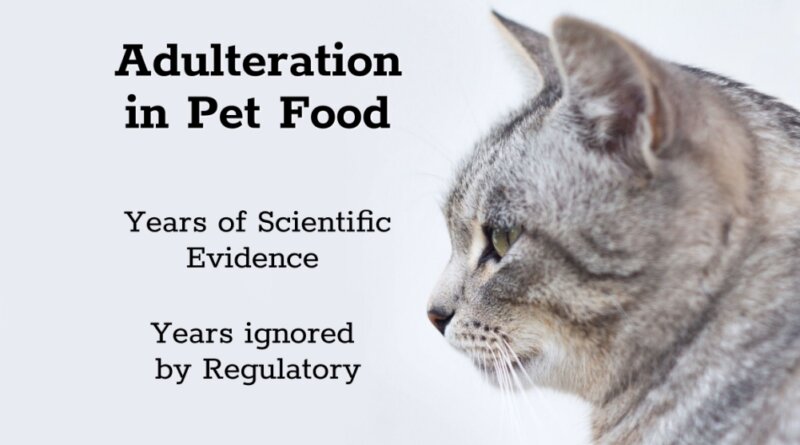Two New Studies Emphasize Pet Food Regulation Failures – Truth about Pet Food
Studies continue to show concerning levels of heavy metals in pet food and adulteration, but FDA continues to ignore the problems.
In 2011, SPEX CertiPrep released a pet food study “Heavy Metals in Pet Food.” The group tested 31 dry food and 27 wet food varieties of cat and dog food finding concerning levels of heavy metals. Ten years later, the same group tested pet food again, “to determine whether heavy metal contamination has significantly changed in the decade following the first study.”
Quoting Spectroscopy report (bold added):
“The original study was conducted in the winter of 2009–2010, covering almost sixty samples. The samples included approximately equal amounts of cat and dog foods, as well as equal amounts of wet canned food and dry kibble. Despite the fact that pet food had been under the control of the FDA since 1938, there was no guidance in 2009 regarding the limits for the most toxic elements to dogs and cats.”
“In 2009, there were significant amounts of metals found in the pet food, with 215 ppm aluminum and over 1 ppm of several potentially toxic metals, including chromium (2.5 ppm), nickel (3.2 ppm), lead (6 ppm), and tin (9.4 ppm). There was 0.5 to 1 ppm of antimony and cobalt. Some foods had correlations of ppm levels of nickel and tin showing large amounts of potential wear metal contamination from the manufacturing equipment. There was even uranium detected in several samples up to 1 ppm.”
What were the results ten years later?
“The samples from 2019 still showed heavy metal contamination, including twice the amount of uranium (1.7 ppm), and three times the amount of arsenic (0.7 ppm). Lead levels were significantly lower overall in the 2019 samples with a maximum of 0.5 ppm, as shown in Table II.”
“In the 2019 study, the levels of uranium, beryllium, and thorium were again examined, and it was found that the 2019 samples had a greater number of samples that contained significant uranium levels than in 2009. The samples set for 2019 contained fourteen samples over 250 ppb compared to only six samples in 2009. Most of the 2019 samples were dry dog foods, which was also consistent with the 2009 study, but in the updated samples, there were two dry cat foods which also measured over 250 ppb, whereas in 2009 there were only dry dog food samples. Nine 2019 samples contained over 500 ppb and four had over 1 ppm, with the highest sample at 1.7 ppm of uranium.”
And significantly, ten years later there remains no limits for heavy metals in pet food regulations. The FDA has taken no action in regulations to limit these toxic elements in pet food.
Another new pet food study from University of Nevada Reno found similar concerning results. From the University website:
“Only two of our tested samples had mercury concentrations above the maximum tolerable levels recommended by the National Research Council,” Sarrah Dunham-Cheatham, assistant research professor at the University of Nevada, Reno and lead author of the paper, said. “The next two highest were dry dog foods from a pet food company that is currently under lawsuit for their high toxic metal concentrations. The top 10 highest foods we tested included six cat foods (three wet, three dry) and four dog foods (all dry).”
“The authors noted that without an established and enforced limit for contaminants such as mercury and methylmercury in pet food products, the pet food industry may continue to make and sell products that pose risks to pets.”
This study also DNA tested pet foods “to test whether actual ingredients matched package labels.” Their findings: “Every sample we looked at had some inaccuracy, based on our results, some more egregious than others. As for the DNA results, generically speaking, we found that many of the pet food products were comprised of low-value ingredients, such as chicken, and that products claiming to be made from high-value ingredients, such as fish and novelty proteins, typically contained more low-value ingredients than high-value ingredients.”
The University of Nevada Reno study (full study available here) stated: “If a consumer cannot trust that a pet food product is free of these allergens, despite the package label, then pet lives are at risk and trust in the pet food industry is severely eroded.”
Multiple studies over many years have also shown pet foods frequently do not contain the ingredients stated on the pet food label. But, to our knowledge, FDA or state regulatory authorities have NEVER investigated this scientifically proven pet food risk or taken any regulatory action against manufacturers.
Should any pet owner wish to share their concern with pet food regulatory authorities, you can email FDA at AskCVM@fda.hhs.gov. Or you can find your state regulatory officials here: https://www.aafco.org/Regulatory.
Wishing you and your pet(s) the best,
Susan Thixton
Pet Food Safety Advocate
Author Buyer Beware, Co-Author Dinner PAWsible
TruthaboutPetFood.com
Association for Truth in Pet Food

Become a member of our pet food consumer Association. Association for Truth in Pet Food is a stakeholder organization representing the voice of pet food consumers at AAFCO and with FDA. Your membership helps representatives attend meetings and voice consumer concerns with regulatory authorities. Click Here to learn more.
What’s in Your Pet’s Food?
Is your dog or cat eating risk ingredients? Chinese imports? Petsumer Report tells the ‘rest of the story’ on over 5,000 cat foods, dog foods, and pet treats. 30 Day Satisfaction Guarantee. Click Here to preview Petsumer Report. www.PetsumerReport.com
Find Healthy Pet Foods in Your Area Click Here

The 2021 List
Susan’s List of pet foods trusted to give her own pets. Click Here to learn more.




